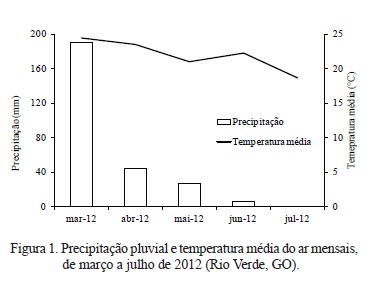Sorghum has a great importance in the world economy as an energy source for food and feed. In the southwest Goiás State, although this culture has a high productive potential, its yield is low, mainly due to the interference of inadequate weed management. This research aimed at determining the periods of weed interference on off-season sorghum crop, in Rio Verde, Goiás State, Brazil. Treatments consisted of ten periods of initial control, in which the crop was kept free of weeds, and ten periods of initial coexistence with weeds. Both the initial periods of control or coexistence, after the crop emergence, were: 0-0, 0-7, 0-14, 0-21, 0-28, 0-35, 0-42, 0-49, 0-56 and 0-harvest (112 days after emergence - DAE). The most important weed species present in the experimental area were Amaranthus lividus, Commelina benghalensis, Bidens pilosa, Sida rhombifolia, Urochloa decumbens, Digitaria horizontalis and Portulaca oleracea. The presence of weeds reduced plant height, stem diameter, grain yield and one thousand grain weight of sorghum, with a higher interference degree for increasing periods of mutual coexistence between the weed community and sorghum. For a 5% tolerance in the reduction of sorghum yield, it was concluded that the period before the interference was up to 23 DAE, the total period of interference prevention up to 42 DAE and the critical period of interference prevention from 23 to 42 DAE.
Sorghum bicolor L.; Poaceae; weed community







